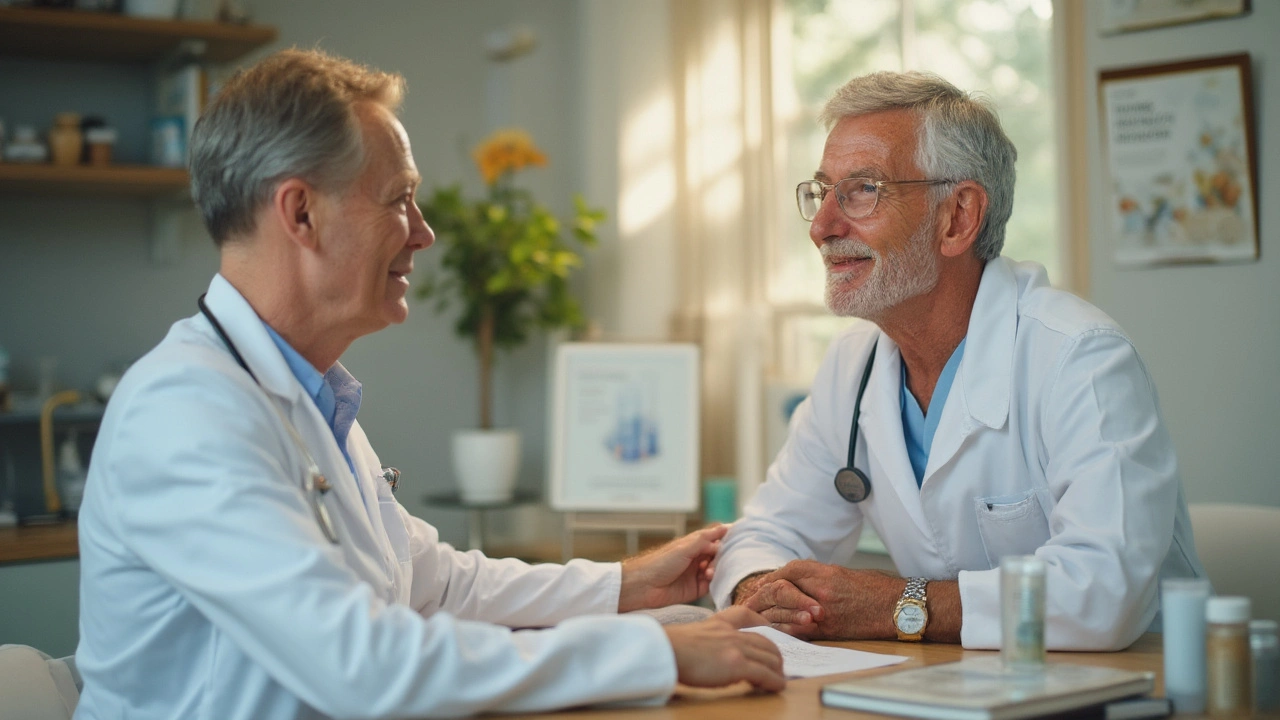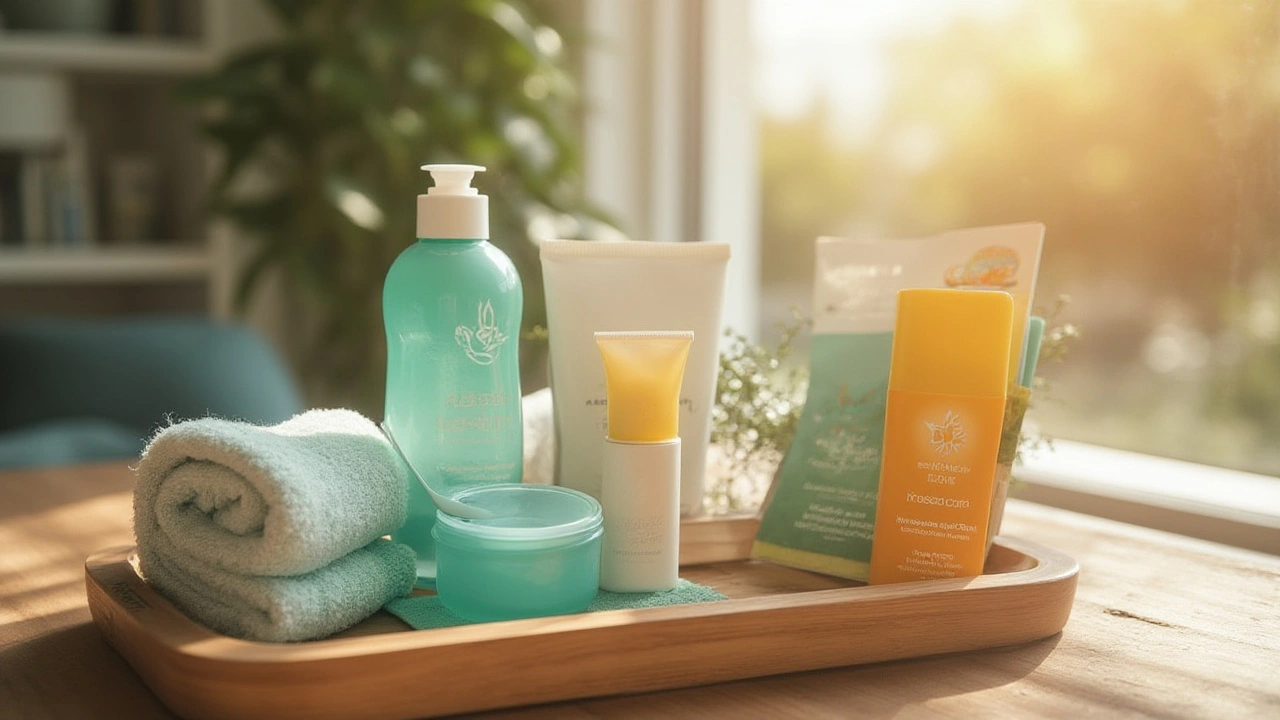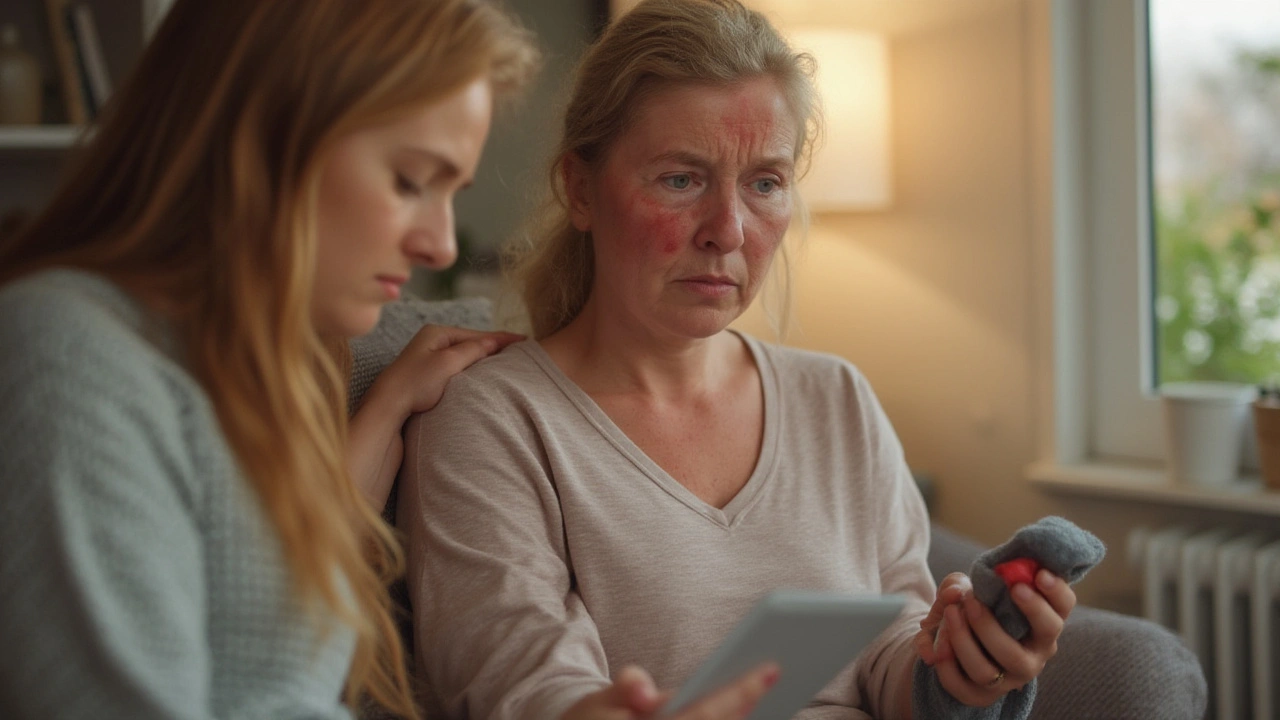Every summer, more people land in the doctor’s office with throbbing, red skin after a little too much sun. Now picture a middle-aged woman who not only scorched her nose and cheeks but also deals with stubborn rosacea flares. Her burning question: how do you heal a severe sunburn without making rosacea spiral out of control? This real case highlights what works—and what can backfire—when treating two angry skin conditions at the same time.
The Complex Relationship Between Sunburn and Rosacea
Rosacea and sunburn don’t just overlap by accident; they amplify each other’s misery. Ultraviolet (UV) exposure is one of the most notorious rosacea triggers. After a beach weekend, our patient’s skin wasn’t just red—it was bumpy, painfully hot, and soon developed those raw, weeping blisters sunburn can bring. She felt desperate for relief, but almost every classic sunburn treatment risks aggravating rosacea’s hypersensitivity.
Doctors see this dual-condition problem regularly, especially among people with fair complexions and a history of facial redness. Severe sunburn alone triggers a highly inflammatory response. In those with rosacea, the risk of extensive swelling, long-lasting red patches, and even visible capillaries (telangiectasia) skyrockets. Some patients even see permanent skin thickening when severe sunburn and chronic rosacea pile up over the years.
Ordinary sunburn treatments like strong corticosteroid ointments pose extra risks for rosacea: if you use them repeatedly on facial skin, they can fuel acne-like bumps or make capillaries more obvious. Even popular cooling gels such as Aloe vera sometimes contain alcohols or fragrances, sparking new flare-ups. No wonder patients feel caught between a rock and a hard place—if you baby the burn, you risk worsening rosacea; if you treat the rosacea, will the sunburn heal?
Recent research shows about 82% of people with rosacea rate sun exposure as their top trigger. Clinical guidelines warn against sunbathing, but real life doesn’t always listen. Surveys of rosacea patients reveal that one accidental sunburn can put them off outdoor activities entirely for months. They may experience burning pain, swelling, and flushing for weeks after a bad burn, not just days. That’s more than a typical sunburn sufferer deals with.
As dermatologists explain, the trick is understanding which treatments soothe both problems without driving either one wild. Getting this right improves both healing outcomes and long-term patient confidence. It also prevents the permanent skin changes that make rosacea more visible, even in winter.
Immediate First Aid: Timing and Tailoring Your Moves
When our patient rushed inside, her cheeks looked like they’d been splashed with hot water. The pain was fierce, too. Quick, careful moves at this stage make all the difference. Forget thick creams or fancy after-sun tonics—less is more. She started by splashing the face with cool water for several minutes, not just dunking once. Consistent, gentle cooling keeps swelling down without shocking the sensitive rosacea-prone skin. Most dermatologists recommend a soft, wet washcloth soaked in cold water, swapped out as soon as it’s no longer chilly. Never use ice directly, since this adds injury.
Our patient’s instinct was to douse her face in aloe gel, but this particular bottle contained lavender fragrance—bad move for rosacea. That stinging sensation many people describe? It’s not soothing at all, as her skin flared even more. After rinsing off, she learned to check ingredients closely for alcohols, dyes, or botanicals known to irritate. For people with both conditions, only very plain gels or formulas labeled “for sensitive, rosacea-prone skin” should touch a sunburn, and even then, do a patch test.
Within an hour, she had developed small blisters on the nose and cheeks. Experienced skin specialists know that popping blisters, even by accident, slows recovery and lets bacteria in. Instead, covering the area with a non-stick, damp dressing stops friction and keeps the outer skin barrier intact. Forget adhesive bandages that tug at delicate skin—use sterile gauze pads saturated with cool water, secured loosely if needed.
Pain was next on the agenda. Over-the-counter pain relief, like acetaminophen, helped, but her doctor avoided nonsteroidal anti-inflammatories (like ibuprofen) at first—they can sometimes worsen facial flushing in rosacea patients. Hydration with cool, plain water (not juice or soda) was encouraged. Topical numbing agents were ruled out: they cause irritation often in rosacea skin and aren’t proven to speed healing anyway.
What about prescription meds? Here’s where nuances matter. Oral antibiotics aren’t typically needed for acute sunburn, unless severe infection sets in. For rosacea, patients sometimes use topical antibiotics or metronidazole. These are paused during sunburn recovery to avoid chemical irritation. The first few days are all about minimal contact, hydration, and keeping the skin cool and uncontaminated.

Evidence-Based Treatments That Actually Work
So what did our patient try that actually made a measurable improvement? Hydration and skin barrier repair were the mainstays. Moisturizers for rosacea must be free from mineral oils, lanolin, fragrance, and strong acids. Liquid paraffin-based products (like the blandest emollient creams) proved lifesavers. They sealed in moisture and offered gentle protection against air and friction. Hydrating mists designed for post-procedure skin were another trick: their fine, alcohol-free formula cooled the skin and offered antioxidants without heaviness.
But maybe the biggest help was learning about photoprotection, even indoors. Windows don’t block all UV rays—especially the UVA that worsens both sunburn and rosacea. After healing began, our patient adopted wide-brimmed hats, light scarves, and daily application of mineral sunscreens containing zinc oxide or titanium dioxide. Chemical sunscreens often burn or tingle on rosacea skin; patients who switch to mineral types see fewer reactions, according to recent double-blind trials. Keeping sunscreen in the fridge adds an extra chill on hot, red skin.
Total avoidance of makeup was necessary for the first week. After that, she only used green-tinted moisturizer, designed to neutralize redness and avoid sticky residue. Her doctor shared that about 62% of severe sunburn patients with rosacea see temporary “mask” hyperpigmentation—lingering brown or gray spots—if strong abrasive scrubs or bleaching creams are used. Instead, healing was slow and steady, with gentle massaging of moisturizer morning and evening.
Antioxidants make a difference, too, but caution is key. Vitamin C serums at high doses can sometimes burn like acid. Instead, gentle niacinamide and vitamin E creams helped repair her skin barrier, based on peer-reviewed trials in dermatology journals over the last three years. A useful tip: beware of homemade ‘natural’ masks. While oatmeal baths can help, not all kitchen remedies are safe—citrus juices are an absolute no-go when treating this combo.
Doctors also stress the importance of emergency plans for future flares. Every rosacea patient with a history of severe sunburn should have a tailored kit: plain mineral sunscreen, a bland emollient, hydrating mist, non-stick bandages, and antihistamines for swelling if prescribed. Having these on hand prevents panic and hasty application of irritating products the next time the sun catches you off guard.
Preventing the Next Burn and Rosacea Flare
If you want to keep summer fun and your cheeks even-toned, prevention has to be more than a slogan. For our patient, it started by rethinking how she spends time outdoors: early mornings or late afternoons replaced midday beach hours. Wide-brimmed hats went from fashion statement to essential hardware.
Sunscreen choices proved surprisingly technical. Labels like ‘broad spectrum’ guarantee protection against both UVA and UVB rays. The sweet spot for rosacea-prone skin: SPF 30+ mineral formulas, ideally fragrance-free and water-resistant. Remember, chemical blockers like oxybenzone or avobenzone often sting these complexions. Even mineral blockers should be patch-tested on a small area of the jawline before going all-in. Applying too little is the number one reason patients still burn—even two teaspoons for the face and neck aren’t excessive on high-UV days. Pat, don’t rub, and reapply every two hours, especially in pool or sweating weather.
Protective clothing offers another layer of smart defense. Old-school cotton doesn’t cut it for long hours outside, but modern UPF-rated fabrics shield more UV than sunscreen alone. Scarves, sun sleeves, and even umbrella hats (yes, really) are popping up on city sidewalks for good reason.
Maintenance routines at home also change post-burn. Lukewarm showers—never hot—followed by patting, not rubbing, skin dry keeps irritation down. She opted for gentle, sulfate-free cleansers meant for babies or allergy-prone adults. Switching pillowcases frequently cut down on bacteria risk while the top layer of her skin rebuilt itself.
The real breakthrough? Her doc recommended tracking flareups in a simple notebook, noting weather, time, diet, and stress for a few weeks after healing. Turns out, post-burn rosacea flares were more likely after spicy food, high alcohol intake, or steamy saunas. Avoiding these triggers for a while helped skin settle down faster.
Peer-reviewed studies show that patients who combine strict sun protection with targeted skincare cut their risk of long-lasting redness by half. Still, after a nasty burn, it can take weeks or even months before your old glow returns. Patience and discipline are the unsung heroes of skin recovery.

When to Get Help—and How to Recover Emotionally
Not every case of sunburn with rosacea turns out to be a quick fix. When blisters cover more than 20% of the face, if there’s weeping from the eyes, or if you’re running a fever, it’s time to see a doctor straight away. Secondary infections, especially from makeup brushes or dirty towels, are a real risk after the skin’s natural defenses are down.
Many people find the emotional fallout even tougher. Facing friends or colleagues with purple-red cheeks, peeling skin, and visible swelling can feel embarrassing or isolating. In one study, 71% of rosacea sufferers described their last severe flare as “socially disabling.” Support from family and frank talks with bosses or teachers—plus a short break from video calls—made a huge difference for our patient.
Counseling or support groups, even online ones, help some people deal with anxiety after skin crises. Dermatologists now routinely ask about mood and social worries after severe sunburn in rosacea patients, since depression rates are noticeably higher in this group. Healing isn’t only about skin barrier—it’s about self-confidence, too.
Finally, our patient found value in learning more from trusted medical sources, especially about the link between rosacea and sunburn. Trustworthy advice let her filter out myths and dodgy home remedies that clutter up Instagram and TikTok. With a plan in place, her skin and confidence bounced back better each summer—proving that evidence-based protocols matched to real-life needs make for a powerful recovery.


ayan majumdar
July 11, 2025 AT 15:28Cool tip: keep the sunscreen in the fridge
Johnpaul Chukwuebuka
July 11, 2025 AT 16:51Hey friends, the first thing is to splash the face with cool water for a few minutes instead of dunking it once
Gentle rinsing reduces swelling without shocking rosacea‑prone skin
Skip ice; it can add injury and make the redness worse
After the water, use a plain, fragrance‑free gel that says it’s for sensitive skin
Pat the skin dry, don’t rub, and stay hydrated with plain water
Xavier Hernandez
July 11, 2025 AT 18:14When sunshine slaps a rosacea‑ridden face, the skin cries out for a compassionate protocol that respects both the burn and the chronic flare
First, the moral imperative is to avoid the treacherous allure of scented aloes that masquerade as miracles while secretly igniting a cascade of irritation
Second, the patient must honor the barrier function of the epidermis by cloaking it in mineral‑based emollients that whisper calm rather than scream chemicals
Third, the practitioner should champion the principle of minimal contact, allowing the dermis to breathe and recover without the tyranny of aggressive topical steroids
Fourth, the prescription of oral antibiotics should be reserved for genuine infection, not as a blanket blanket for every reddening episode
Fifth, the price of negligence is paid in permanent capillary visibility and psychosocial anguish, a cost society can no longer afford to ignore
Sixth, the sun’s ultraviolet betrayal can be thwarted by mineral sunscreens that sit like a gentle shield, devoid of the stinging bots of avobenzone or oxybenzone
Seventh, the patient’s daily ritual must include a chilled mist, for the cold solace soothes the inflamed nerves and curtails the inflammatory firestorm
Eighth, a disciplined notebook tracking triggers-spicy fare, alcohol, stress-empowers the individual to pre‑empt future flares with scientific rigor
Ninth, the avoidance of makeup for at least a week underscores the reverence for natural healing, while the eventual use of green‑tinted moisturizers offers chromatic camouflage without aggression
Tenth, the community of dermatologists bears the ethical duty to educate about the perils of DIY remedies that, while charming on TikTok, may harbor citrus acids that scorch delicate rosacea skin
Eleventh, we must condemn the cultural myth that “a little sun is harmless” for those with vascular sensitivity, for it perpetuates harm under the guise of bronzed beauty
Twelfth, the integration of emotional support-counseling, peer groups, compassionate dialogue-recognizes that healing is as much mental as it is dermal
Thirteenth, the ultimate triumph lies in a synergy of evidence‑based science and humane care, restoring not just the complexion but the confidence of the patient
Fourteenth, only through such a holistic, morally conscious approach can we truly vanquish the twin tyrants of severe sunburn and relentless rosacea
Fifteenth, let us pledge to disseminate this knowledge, for the collective welfare of every reddened visage depends upon it
Zach Yeager
July 11, 2025 AT 19:38While the simple water splash works, remember that true protection comes from standing proud under our own flag of sunlight and using home‑grown remedies that respect our heritage
Angel Gallegos
July 11, 2025 AT 21:01Your florid moralization, while earnest, obscures the practical dermatological facts with excessive rhetoric
Professional guidance should prioritize clear, evidence‑based steps rather than grandiloquent appeals
Moreover, the assertion that “society can no longer afford” is hyperbolic and detracts from actionable advice
Precision in language is as vital as precision in treatment
ANTHONY COOK
July 11, 2025 AT 22:24Nice point about pride 🇺🇸 but keep in mind that over‑the‑counter creams can still sting – stay smart 😑